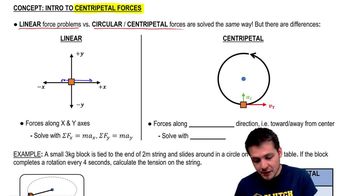Here are the essential concepts you must grasp in order to answer the question correctly.
Gravitational Force
The gravitational force is the attractive force between two masses, described by Newton's law of universal gravitation. It states that the force is proportional to the product of the two masses and inversely proportional to the square of the distance between their centers. In this scenario, each planet experiences the gravitational pull from the star, which is essential for maintaining its orbit.
Recommended video:
Gravitational Forces in 2D
Centripetal Force
Centripetal force is the net force required to keep an object moving in a circular path, directed towards the center of the circle. For the planets in orbit, this force is provided by the gravitational attraction from the star. The balance between gravitational force and centripetal force determines the conditions for stable orbits and is crucial for deriving the orbital period.
Recommended video:
Intro to Centripetal Forces
Orbital Period
The orbital period is the time taken for a planet to complete one full orbit around a star. It can be derived using Kepler's laws of planetary motion and is influenced by the mass of the star and the radius of the orbit. In this case, the orbital period can be calculated by equating the gravitational force to the required centripetal force, leading to a formula that relates these quantities.
Recommended video:




